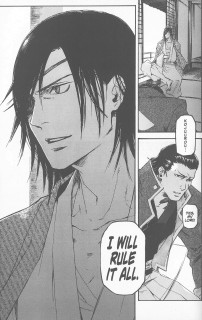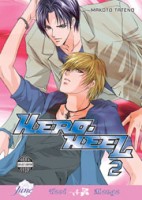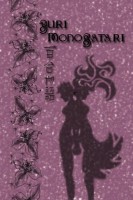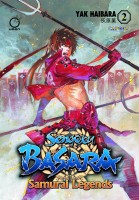 Creator: Yak Haibara
Creator: Yak Haibara
U.S. publisher: Udon Entertainment
ISBN: 9781926778594
Released: February 2013
Original release: 2008-2009
Yak Haibara’s four-volume manga series Sengoku Basara 2 is an adaptation of the video game known by the same name. The manga was released in English by Udon Entertainment in two omnibus volumes under the title Sengoku Basara: Samurai Legends. The second omnibus, collecting the third and fourth volumes of Haibara’s Sengoku Basara 2 released in Japan in 2008 and 2009 respectively, was published in 2013. The Sengoku Basara franchise had its beginnings in 2005 as a series of video games but it has since spawned multiple manga and anime series among other things. Samurai Legends was actually my introduction to Sengoku Basara as a whole and it stands fairly well as its own work. Prior exposure to Sengoku Basara isn’t really necessary to enjoy or understand Samurai Legends, although it might not hurt to have some basic knowledge of Japan’s Warring States period upon which it is very loosely based.
In the aftermath of the devastating defeat of the armies of both Kai Takeda and Kenshin Uesugi at Kawanaka Island, very little stands between the forces of Hideyoshi Toyotomi and Masamune Date to prevent them from clashing head on. While there are now fewer contenders vying for control over Japan, the battle for supremacy is still fierce. Toyotomi relies on his own power and strength as well as the skills of his master strategist Hanbei Takenaka, destroying anyone and anything in his path and using fear to rule. Date, too, has an excellent strategist in the talented Kojuro Katekura, but his rise to power has been significantly less destructive, at least when compared to that of Toyotomi. Knowing that they must contend with each other, the two warlords have set their sights on Odawara Castle, a fortress that if conquered will grant the victor an immense advantage in claiming Japan as his own.
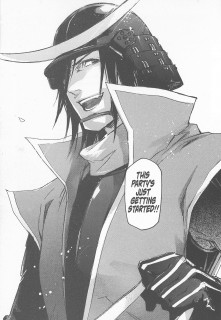 While Samurai Legends is inspired by actual historical figures and events from Japan’s sixteenth-century, the manga, like the rest of Sengoku Basara, makes no attempt at realism or authenticity. Quite the opposite in fact—the series is deliberately over-the-top and anachronistic. The dialogue and trash talk is very contemporary in its style, giving the characters tremendous attitudes with a modern bent. (“Dude, seriously? You wanna dance with me!?”) Additionally, Date’s army is basically portrayed as a bōsōzoku gang, complete with pompadours, although his forces do ride horses instead of motorcycles. And when it comes to actually battling things out, a frequent occurrence in Samurai Legends, the amount of damaged caused and incurred by the overpowered fighters is impressive to say the least, though hardly believable. But that’s part of what makes Sengoku Basara so great. It’s ridiculous and outrageous.
While Samurai Legends is inspired by actual historical figures and events from Japan’s sixteenth-century, the manga, like the rest of Sengoku Basara, makes no attempt at realism or authenticity. Quite the opposite in fact—the series is deliberately over-the-top and anachronistic. The dialogue and trash talk is very contemporary in its style, giving the characters tremendous attitudes with a modern bent. (“Dude, seriously? You wanna dance with me!?”) Additionally, Date’s army is basically portrayed as a bōsōzoku gang, complete with pompadours, although his forces do ride horses instead of motorcycles. And when it comes to actually battling things out, a frequent occurrence in Samurai Legends, the amount of damaged caused and incurred by the overpowered fighters is impressive to say the least, though hardly believable. But that’s part of what makes Sengoku Basara so great. It’s ridiculous and outrageous.
The first omnibus of Samurai Legend moved fairly quickly from one battle to the next. The second omnibus also as plenty of action, but the pacing doesn’t seem quite as frantic. Haibara takes more time to delve into the personal motivations of the primary players in the series’ conflict, revealing what drives them to conquer and unify Japan. While in the end the characters still aren’t particularly subtle or nuanced, this does provide them with more depth. I appreciate it when there is more complex meaning behind a fight than a simple lust for power; the second omnibus clarifies the underlying purpose of the war, making the battles even more thrilling. Samurai Legends is a bombastic series, and a least one major continuity error does slip in amid all of the excitement. However, I’m actually willing to forgive this simply because the manga is so incredibly entertaining otherwise. In the immortal words of Keij Maeda, “As long as you’re having fun, it’s all good.”


